NHL All-Star Weekend continues with a look at the evolution of the event into an annual part of the NHL calendar, although perhaps not were you would normally expect it to be.
Following the first three benefit/memorial games held in the 1930's, there were no NHL All-Star games held until the Players Committee proposed it as an annual charity game to benefit the Players Emergency Fund as well as a players pension fund in 1947.
The first of the annual games was held in Toronto's Maple Leaf Gardens,which was upgraded to have glass on the boards instead of the usual fencing that was common at the time, on October 13, 1947. When it first began, the format called for the defending Stanley Cup Champions to take on an All-Star team made up of players from the other five Original 6 clubs, with the game to be played prior to the start of the regular season.
The inaugural 1947 NHL All-Star Game program
The scheduling of the game would remain during the pre-season (or at least very early in the season) through 1965. It was then shifted to a mid-season spot on the calendar for the 1966-67 season, which meant there was no game during the 1966 calendar year.
The practice of having the defending Stanley Cup champions take on the All-Stars lasted through 1968 before a change was made to have the Eastern Conference battle the Western Conference All-Stars for the first time. The only exception to this format was in 1951 and 1952, when the end of season First Team All-Stars played against the end of season Second Team All-Stars, with both games ending in ties.
During the era when the Stanley Cup champions would face an All-Star team, the All-Stars prevailed nine times, the cup champions seven and there were three ties.
Prior to the first NHL All-Star Game, the players attended a Canadian Football League game and were treated to a fine dinner. Gifts were given to all the players, with the defending champion Maple Leafs each receiving extra gifts, such as gold cufflinks, a lifetime pass to Maple Leaf Gardens, a coat, a hat and tie, a lighter and cigarette box, golf balls, a pocket knife, a team photo, a silver tea tray and and engraved gold watch with a silver chain.
The Maple Leafs earned their place in the first NHL All-Star Game
by winning the 1947 Stanley Cup championship
The game was played in front of 14,169 fans who saw the Maple Leafs leading at the conclusion of the first period by a score of 1-0 on a goal by Harry Watson at 12:29 of the first period with an assist from Bill Ezinicki.
The Maple Leafs extended their lead with a second goal just 1:03 into the second period by Ezinikci from team captain
Syl Apps and Watson before the All-Stars got on the board at 4:39 when the Chicago Black Hawks
Max Bentley scored from
Ken Reardon of the Montreal Canadiens. The Maple Leafs responded just 22 seconds later to restore their two goal margin when Apps scored with an assist from Watson, his third point of the game at 5:01. The All-Stars scored their second of the period just before the halfway point of the game at 9:25 from
Grant Warwick with assists going to
Edgar Laprade (of the New York Rangers) and Reardon to make it 3-2 for Toronto after two periods.
The Canadiens
Maurice Richard tied the game for the All-Stars with an unassisted goal just 28 seconds into the third period, followed by
Doug Bentley's game winner less than a minute later from the Boston Bruins
Milt Schmidt and Richard as the All-Stars would come from behind to win 4-3.
The reunion of the original 1947 All-Star Game players in 2000 at
the 50th NHL All-Star Game, also held in Toronto
The Maple Leafs wore their home white sweaters for the game and the referees wore dark blue sweaters.
The NHL All-Stars wore newly designed red sweaters adorned with the NHL logo and white stars arched over the logo on the chest and short white and blue stripes which repeated across the shoulders and down the length of the arms.
The 1947 NHL All-Star Team, the first to wear the new All-Star design
This style of All-Star jersey would remain in use through 1954 until a change in NHL policy saw the home teams now wearing their dark jerseys, which led to a revival of the white version of this sweater for the All-Stars first used in 1951 and 1952 when the format of the game was tweaked to feature the NHL First Team All-Stars facing the Second Team All-Stars with one team wearing the red version and the other the white.
The 1951 NHL Second All-Star Team,
the first to wear the white version of the All-Star sweater
The white sweaters were then used from 1955 through 1959 until a new design was finally adopted in 1960. This style jersey was revived for the 1993 NHL All-Star Game in Philadelphia during the NHL's 75th Anniversary season.
Today's featured jersey is a
1947 NHL All-Star Maurice "Rocket" Richard jersey
as worn in the first of the annual NHL All-Star Games. This design was
created specifically for the first of the annual NHL All-Star Games and
would remain in use through 1959, although sometimes in a white version.
Today's bonus jersey is a
1947 NHL All-Star Emile "Butch" Bouchard jersey also worn in the first of the annual NHL All-Star Games by Richard's Canadiens teammate.
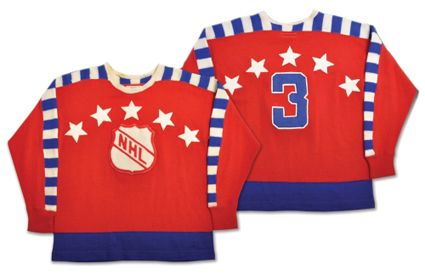
photo courtesy of Classic Auctions
Extra bonus jersey: Today's extra bonus jersey is a 1947-48 Toronto Maple Leafs Ted "Teeder" Kennedy jersey as worn by the defending Stanley Cup champion Maple Leafs in the first of the annual NHL All-Star Games in 1947 just prior to the start of the season.
The Maple Leafs adopted this striping pattern for their white jerseys back in 1937-38 to match that worn on their blue jerseys since 1934-35. They added this redesigned crest for the 1938-39 season and these sweaters were then worn through the 1957-58 campaign until a redesign arrived for the following season.
Today's video section is a newsreel introduction to the original NHL All-Star Game in 1947.


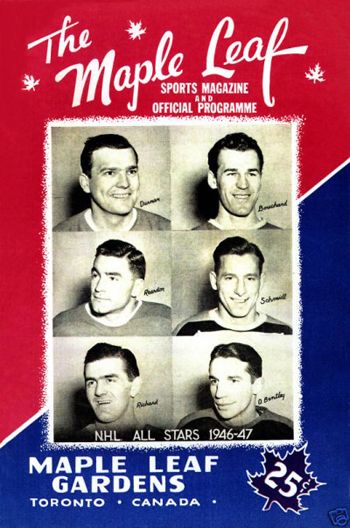

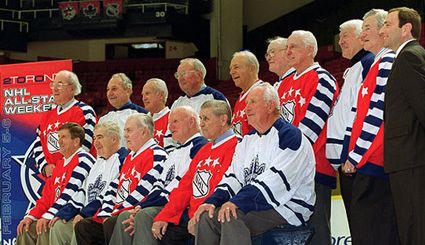
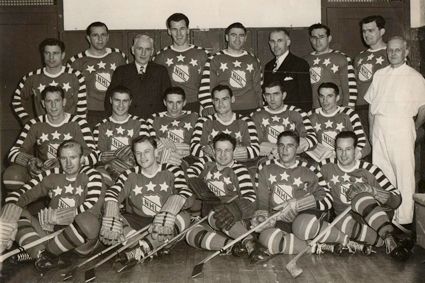
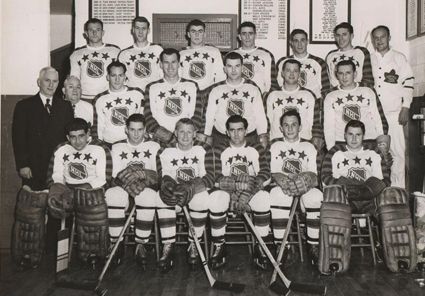
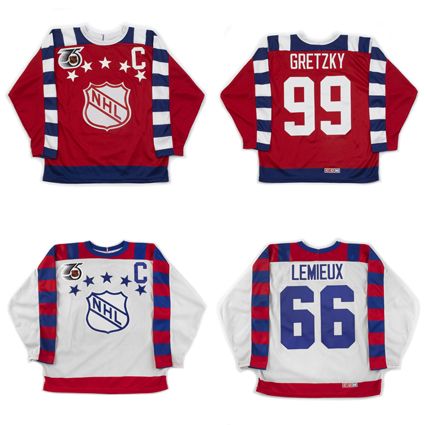
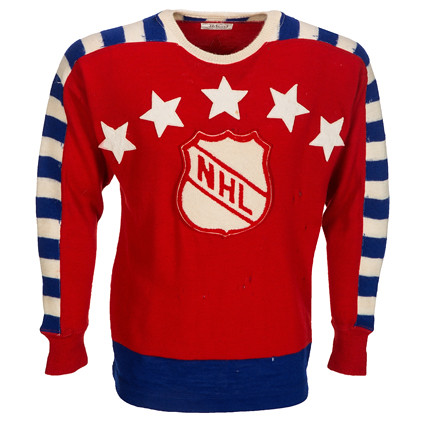
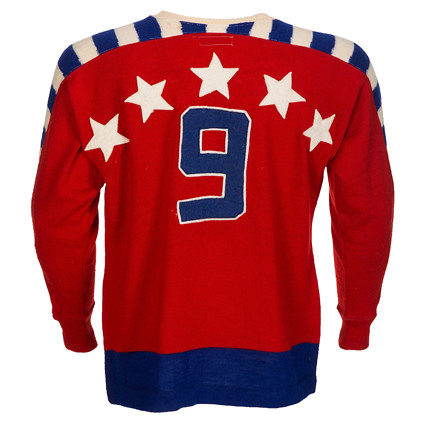
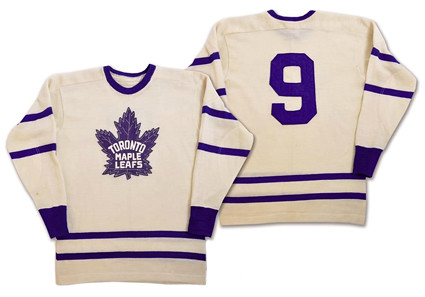










No comments:
Post a Comment
We welcome and encourage genuine comments and corrections from our readers. Please no spam. It will not be approved and never seen.